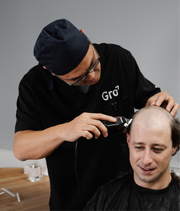Scalp micropigmentation (SMP) is a non-invasive cosmetic tattooing procedure that creates the appearance of closely cropped or denser hair. At Gro Clinics, SMP is offered at our Melbourne clinic as one of several options available for individuals exploring visual solutions to hair loss.
This guide explores how scalp micropigmentation works, what to expect, and how it compares with other hair restoration options like transplants and prescription treatments.
What Is Scalp Micropigmentation?
SMP involves applying pigment to the upper layers of the scalp in a way that mimics the look of tiny hair follicles. It does not stimulate new hair growth but can help reduce the contrast between hair and scalp in thinning areas, or replicate the look of a shaved head.
How It Works
- A fine needle deposits pigment into the scalp using a specialised technique
- Each dot is placed to replicate natural follicle placement
- The result can simulate a buzz-cut appearance or visual density
Is Scalp Micropigmentation Permanent?
SMP is considered a semi-permanent treatment. While the pigment is long-lasting, it fades over time due to skin regeneration. Many clients choose to refresh their treatment every few years to maintain consistent results.
Does SMP Grow Hair?
No. Scalp micropigmentation is a cosmetic procedure and does not alter the biology of the scalp or hair follicles. It does not restore lost hair or stimulate growth. For treatments that may support hair regrowth, explore our prescription hair care options which may be discussed during a consultation with a Gro Hair Growth Advisor.
When Is SMP a Good Option?
SMP may be suitable for:
- People experiencing diffuse thinning who want to reduce scalp visibility
- Individuals who prefer a shaved head look but want more definition
- Those seeking a non-medical, visual approach to hair loss
- Clients not eligible for or not pursuing hair transplant procedures
SMP at Gro Clinics Melbourne
At Gro, we offer scalp micropigmentation in our Melbourne clinic as part of our broader approach to hair restoration. The procedure is performed in a controlled clinical setting and begins with a consultation to assess your goals and scalp condition.
Pros of Scalp Micropigmentation
- Non-invasive and needle-based—no surgical incision or downtime
- Can create the illusion of density in thinning areas
- Useful for camouflaging scars or blending uneven hair patterns
- Requires minimal maintenance between touch-ups
Limitations of SMP
- Does not restore hair or improve follicle health
- May fade over time and require retouching every 3–6 years
- Visual-only—texture and feel remain unchanged
- Requires careful selection of pigment shade to match existing hair
SMP vs Hair Transplantation
Hair transplants involve relocating hair follicles from areas of stable growth to areas of loss. Transplanted follicles may continue to grow hair naturally in their new location. Scalp micropigmentation, by contrast, is a purely visual approach and does not involve hair follicle relocation or regeneration.
Our transplant procedures are performed or overseen by doctors, and clients first meet with a Hair Growth Advisor to determine what options may be appropriate for them. We also offer guidance on superannuation access for eligible cases.
Is SMP Right for You?
There’s no one-size-fits-all solution when it comes to hair restoration. The decision between SMP, hair transplant procedures, or medical treatments should be informed by your goals, budget, medical history, and lifestyle preferences.
To learn more about what's suitable for your needs, book a consultation with a Gro Hair Growth Advisor. We’ll help you explore options tailored to your situation.
Gro Clinics Locations
Gro Clinics operates across Australia and New Zealand. Visit a clinic near you:
Book your consultation online here or call us on 1300 787 563 to get started.



















